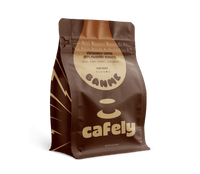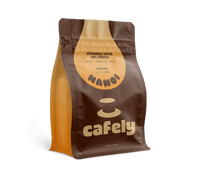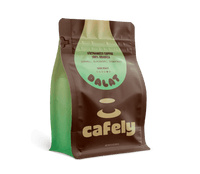Coffee is grown in several countries across Africa, South America, and Asia. The coffee-growing countries in these regions all have one thing in common — the climate.
Coffee plants — species in the Coffea genus such as C. arabica and C. robusta — thrive in warm, humid environments with frequent rainfall. Coffee-growing countries have similar climates. However, subtle differences in weather, soil, and altitude affect the flavors of the beans.
Read on to learn where coffee is grown, which countries grow the most coffee, and how the characteristics of coffee beans vary by country…
Different Types of Coffee Beans

Over 120 different species of Coffea (coffee plants) have been discovered so far. However, only two of these species are mass-produced, and fewer than 20 are used in small-scale productions.
1. Arabica Coffee Beans
Arabica coffee beans makes up around 60% of the world's coffee production. It's the most popular bean in the West because of its smooth, sweet flavor profile. It's commonly used to make espresso coffee and milk-based beverages such as café latte, cappuccino coffee, flat white, and macchiato coffee.
Arabica coffee is grown across the globe in warm, humid, high-altitude environments. South America produces most of the world's arabica coffee, but it's also cultivated in Africa and Asia.
2. Robusta Coffee Beans
Robusta coffee makes up the remaining 40% of the world's coffee production. It's not as popular in the West because it has a dark, intense, bitter flavor. However, it's loved in Southeast Asia for its high caffeine content and bold flavor profile that combines well with sweetened condensed milk.
Robusta coffee plants are much less sensitive than arabica plants, meaning they can be cultivated in a wider range of environments. Most of the world's robusta is grown in Southeast Asia, with Vietnam the leading producer.
3. Other Coffee Bean Types
Other coffee species make up less than 3% of the world's total coffee production. These specialty beans are usually grown on small-scale farms that focus on rare or historical genetics. Small-scale artisan coffee producers can be found across the globe in Africa, Asia, and South America.
Other coffee beans include:
- Liberian coffee (Coffea liberica)
- Excelsa coffee (Coffea excelsa)
- Stenophylla coffee (Coffea stenophylla)
- Charrieriana coffee (Coffea charrieriana)
The Coffee Bean Belt
The “coffee bean belt” is a geographical strip across where most of the world's coffee is cultivated. It lies between the “Tropic of Cancer” and the “Tropic of Capricorn” — two imaginary lines of latitude that mark 23.5 degrees north and 23.5 degrees south of the equator, respectively.
The coffee bean belt provides the ideal conditions for growing coffee — warm temperatures, consistent rainfall, and rich soils.
Several of the world's major coffee-producing countries lie in this geographical belt, including:
- Brazil (the largest coffee producer)
- Colombia
- Honduras
- Guatemala
- Peru
- Ethiopia (the birthplace of coffee)
- Kenya
- Uganda
- Rwanda
- Vietnam (the largest robusta coffee producer)
- Indonesia (famed for Java coffee)
- India
- Papua New Guinea
Top Five Coffee Growing Regions

Most of the world's coffee is produced in just a handful of countries.
These are the top five coffee-growing countries, how much coffee they produce, and which types are grown there:
1. Brazil
Brazil is the world's largest coffee producer, contributing around 35% to 40% of the global coffee supply. It produces an average of 3.7 billion kilograms of coffee per year. Around 70% of its production is arabica with the remaining 30% robusta.
Brazilian arabica coffee is known for its smooth, nutty, chocolatey flavor and low acidity.
2. Colombia
Colombia is one of the world's top arabica coffee producers. It produces around 10% to 15% of the world's coffee — roughly 800 million kilograms per year.
This country produces mostly arabica coffee with a small percentage of robusta. Colombian coffee is balanced and bright with notes of caramel and fruit.
3. Vietnam
Vietnam is the second-largest coffee producer in the world. It contributes to around 17% to 20% of the global coffee supply. Around 1.8 billion kilograms of coffee are produced in Vietnam every year with the majority of the beans being robusta. This country produces around 95% robusta and 5% arabica.
Vietnamese robusta coffee is famed for its bold, dark, earthy flavor profile and high caffeine content — around twice that of arabica.
4. Ethiopia
Ethiopia is the birthplace of coffee. Coffea arabica and Coffea robusta were first discovered in this country. It produces around 3% to 4% of the world's coffee and solely produces arabica — a minute percentage of robusta is cultivated in the country.
Ethiopia produces around 450 million kilograms of coffee per year. Its beans are renowned for their floral, fruity, tropical flavors and bright acidity.
5. Indonesia
Indonesia produces around 700 million kilograms of coffee per year — making up around 6% to 7% of the world's coffee supply.
This country is famed for its unique arabica coffee called java coffee that's grown on the island of Java. However, it produces more robusta than arabica — around 75% and 25% respectively.
Indonesia is famed for its earthy, spicy, and full-bodied coffee with hints of chocolate, cinnamon, and tobacco.
How Are Coffee Beans Produced?
Coffee beans go through a long, time-consuming journey from farm to cup. Producing coffee beans isn't as simple as growing a coffee plant and harvesting its seeds — several steps are required to make the beans usable for brewing.
Here's how coffee beans are produced:
1. Growing and Harvesting
The process begins where it ends — with a “coffee bean” which is the seed of the coffee plant.
The seed is planted and nourished until it blossoms into a healthy coffee plant. It can take anywhere from three to four years for a coffee plant to mature and produce cherries — the seed-bearing fruit.
The plants are grown on farms in tropical countries across the globe. When they mature and produce fruits, the cherries are harvested — usually by hand.
2. Processing the Cherries
Once the coffee cherries are harvested, they must be processed to extract the seeds (coffee beans) from the flesh of the fruit. There are two main coffee cherry processing methods:
- Washed (Wet) Processing — The cherries are pulped (where the flesh is broken up) and fermented. The beans are then removed, washed, and dried. Wet processing produces coffee beans with clean, bright flavors.
- Natural (Dry) Processing — The cherries are dried whole without pulping before the beans are removed, washed, and dried. Dry processing produces coffee beans with sweeter, fruitier flavors.
3. Drying and Milling the Beans
Once the cherries are processed and the beans are removed, they must be dried. This is done by sun drying or dehydration (machines) until the beans reach a moisture level of 10% to 12%.
The beans are then milled — this removes the parchment layer and any remaining cherry pulp that's still on the beans.
4. Sorting and Grading the Beans
Once the beans have been dried and milled, they must be sorted and graded.
The beans are sorted by size, weight, and defects by using machines and visual inspection. The beans are then graded depending on quality.
High-quality beans that are consistent in size and shape are set aside for whole-bean and ground coffee. Lower-quality beans are set aside for ground blends and instant coffee.
5. Roasting the Beans
Once the beans have been sorted and graded, they move on to the final step in the process. Before roasting, the beans are raw, white in color, and would produce a grassy, sour taste if brewed.
The roasting process transforms the beans and brings out the complex flavors within through the Maillard reaction and caramelization.
The beans are placed in a roaster — a rotating drum that evenly distributes heat throughout its contents. They're roasted at a temperature between 356°F to 464°F (180°C to 240°C).
The amount of time the beans are roasted affects their flavor.
- Light roasts take eight to 10 minutes and produce bright, acidic, fruity flavors.
- Medium roasts take 10 to 12 minutes and produce balanced sweetness, mild acidity, and caramel-like flavors.
- Dark roasts take 12 to 14 minutes and produce bold, dark, nutty flavors.
- French roasts take 14 to 16 minutes and produce brews with intense, bitter, and slightly burnt flavors.
Single Origin vs. Blends: What's the Difference

If you're interested in coffee, you've likely heard of the terms “single origin” and “blend.” So what's the difference between these types of coffee?
Single Origin Coffee
Single-origin coffee contains beans sourced from one specific country, region, or farm.
Single-origin coffees highlight the unique flavors of a single environment. They're favored for their unique and distinct flavor profiles that celebrate the "taste" of the land the coffee was harvested from.
The limited geographical regions single blends are harvested from can mean flavors change year-on-year. The growing conditions vary depending on the year — this can be noticed in the coffee's characteristics.
A single-origin coffee from the same place can taste surprisingly different from one year to the next.
Coffee Blends
Coffee blends are crafted from coffee beans sourced from a variety of regions, countries, and farms. The beans are blended to create a balanced and consistent flavor.
Unlike single-origin coffee, blends aren't affected by climatic changes from one year to the next. If a growing season from one region is poor, roasteries will swap the beans for another. This means the taste of a blend is (more or less) the same regardless of when the beans were harvested.
Blends of arabica and robusta are ideal for people who prefer a consistent coffee with the same taste day in and day-out.
FAQs: Where is Coffee Grown?
Want to learn more about coffee, where it's grown, and how it’s processed?
Check out the answers to the frequently asked questions below:
1. What Country Grows the Most Coffee?
Brazil is the largest coffee producer in the world. It produces 66.3 million kilograms of coffee per year — that makes up around 39% of the total global coffee production.
Around 72% of Brazil's coffee production is arabica, with the remaining 28% robusta. Vietnam is the biggest producer of robusta coffee is the biggest producer of robusta coffee. It produces around 27.5 million kilograms — 16% of the world's coffee production.
2. Where is Arabica Coffee Grown?
Arabica coffee is grown across the globe. The biggest producer of arabica coffee is Brazil, followed by Colombia. The rich soils, warm climate, and high altitudes of South America are perfect for arabica production.
3. Where is Robusta Coffee From?
Robusta coffee variety — like most coffee species — originates from Africa. Robusta is native to Central and West Africa but is now cultivated across the globe in several different regions. It's most commonly grown in Southeast Asia, with Vietnam as the largest global producer dominating around 16% of the world's coffee production.
4. What is Liberica Coffee?
Liberica coffee is made from the beans of the Coffea liberica species. It's a rare species that's grown in small quantities — it makes up less than 1% of the world's coffee production. Liberica coffee has woody, smoky, nutty notes with floral and fruity undertones.
5. How Much Coffee is Grown in Vietnam?
Vietnam produces around 27 million kilograms of coffee per year. In terms of market share, that's around 16%.
6. Can You Grow Coffee at Home?
Yes. It's possible to grow coffee at home. Coffee plants make excellent houseplants. However, you're unlikely to produce any usable coffee beans unless you live in a country with a tropical climate.
7. How Many Species of Coffee Exist?
There are over 120 different species of coffee. However, only a handful are grown to produce drinkable coffee. Species of Coffea arabica and Coffea robusta are the two most popular — making up around 98% of the world's coffee production. The other 2% is made up of rarer species such as Coffea liberica and Coffea stenophylla.
8. How Are Coffee Beans Roasted?
Green coffee beans are roasted in a large roasting drum that rotates to provide even heat distribution. The beans are heated to 350 to 500°F (175 to 260°C). The amount of time they spend in the roaster affects the roast level. Light roasts take less time, and dark or French roasts coffee take longer.
9. How Long Does Coffee Stay Fresh After Harvesting?
Green coffee beans last for six to 12 months after harvest if they're stored in an airtight container in a cool, dark place. They can last for up to two years if properly dried and vacuum sealed. Freshly roasted coffee beans last for two to four weeks after roasting. They may last longer than this, but they will go stale over time — losing flavor and aroma.
10. Where is the Most Expensive Coffee From?
Kopi luwak from Indonesia is the most expensive and exclusive coffee in the world. It costs so much because the beans are consumed by palm civets, partially digested, cleaned, and roasted. This process ferments the beans and gives them a unique, rich flavor.












